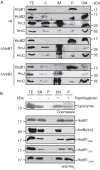The periplasmic HrpB1 protein from Xanthomonas spp. binds to peptidoglycan and to components of the type III secretion system
- PMID: 23934485
- PMCID: PMC3811196
- DOI: 10.1128/AEM.01226-13
The periplasmic HrpB1 protein from Xanthomonas spp. binds to peptidoglycan and to components of the type III secretion system
Abstract
The plant-pathogenic bacterium Xanthomonas campestris pv. vesicatoria employs a type III secretion (T3S) system to translocate bacterial effector proteins into eukaryotic host cells. The membrane-spanning secretion apparatus consists of 11 core components and several associated proteins with yet unknown functions. In this study, we analyzed the role of HrpB1, which was previously shown to be essential for T3S and the formation of the extracellular T3S pilus. We provide experimental evidence that HrpB1 localizes to the bacterial periplasm and binds to peptidoglycan, which is in agreement with its predicted structural similarity to the putative peptidoglycan-binding domain of the lytic transglycosylase Slt70 from Escherichia coli. Interaction studies revealed that HrpB1 forms protein complexes and binds to T3S system components, including the inner membrane protein HrcD, the secretin HrcC, the pilus protein HrpE, and the putative inner rod protein HrpB2. The analysis of deletion and point mutant derivatives of HrpB1 led to the identification of amino acid residues that contribute to the interaction of HrpB1 with itself and HrcD and/or to protein function. The finding that HrpB1 and HrpB2 colocalize to the periplasm and both interact with HrcD suggests that they are part of a periplasmic substructure of the T3S system.
Figures






Similar articles
-
The Predicted Lytic Transglycosylase HpaH from Xanthomonas campestris pv. vesicatoria Associates with the Type III Secretion System and Promotes Effector Protein Translocation.Infect Immun. 2017 Jan 26;85(2):e00788-16. doi: 10.1128/IAI.00788-16. Print 2017 Feb. Infect Immun. 2017. PMID: 27895129 Free PMC article.
-
Type III-Dependent Translocation of HrpB2 by a Nonpathogenic hpaABC Mutant of the Plant-Pathogenic Bacterium Xanthomonas campestris pv. vesicatoria.Appl Environ Microbiol. 2016 May 16;82(11):3331-3347. doi: 10.1128/AEM.00537-16. Print 2016 Jun 1. Appl Environ Microbiol. 2016. PMID: 27016569 Free PMC article.
-
Characterization of HrpB2 from Xanthomonas campestris pv. vesicatoria identifies protein regions that are essential for type III secretion pilus formation.Microbiology (Reading). 2012 May;158(Pt 5):1334-1349. doi: 10.1099/mic.0.057604-0. Epub 2012 Feb 16. Microbiology (Reading). 2012. PMID: 22343358
-
Type III effector proteins from the plant pathogen Xanthomonas and their role in the interaction with the host plant.J Plant Physiol. 2006 Feb;163(3):233-55. doi: 10.1016/j.jplph.2005.11.011. Epub 2005 Dec 28. J Plant Physiol. 2006. PMID: 16386329 Review.
-
Protein export according to schedule: architecture, assembly, and regulation of type III secretion systems from plant- and animal-pathogenic bacteria.Microbiol Mol Biol Rev. 2012 Jun;76(2):262-310. doi: 10.1128/MMBR.05017-11. Microbiol Mol Biol Rev. 2012. PMID: 22688814 Free PMC article. Review.
Cited by
-
Key steps in type III secretion system (T3SS) towards translocon assembly with potential sensor at plant plasma membrane.Mol Plant Pathol. 2015 Sep;16(7):762-73. doi: 10.1111/mpp.12223. Epub 2015 Jan 29. Mol Plant Pathol. 2015. PMID: 25469869 Free PMC article. Review.
-
Secrete or perish: The role of secretion systems in Xanthomonas biology.Comput Struct Biotechnol J. 2020 Dec 24;19:279-302. doi: 10.1016/j.csbj.2020.12.020. eCollection 2021. Comput Struct Biotechnol J. 2020. PMID: 33425257 Free PMC article. Review.
-
Morphogenetic penicillin-binding proteins control virulence-associated type III secretion systems in Salmonella.Infect Immun. 2025 Feb 18;93(2):e0055524. doi: 10.1128/iai.00555-24. Epub 2024 Dec 31. Infect Immun. 2025. PMID: 39745378 Free PMC article.
-
Xanthomonas campestris pv. vesicatoria Secretes Proteases and Xylanases via the Xps Type II Secretion System and Outer Membrane Vesicles.J Bacteriol. 2015 Sep;197(17):2879-93. doi: 10.1128/JB.00322-15. Epub 2015 Jun 29. J Bacteriol. 2015. PMID: 26124239 Free PMC article.
-
The Cpx envelope stress response modifies peptidoglycan cross-linking via the L,D-transpeptidase LdtD and the novel protein YgaU.J Bacteriol. 2015 Feb;197(3):603-14. doi: 10.1128/JB.02449-14. Epub 2014 Nov 24. J Bacteriol. 2015. PMID: 25422305 Free PMC article.
References
-
- Leyns F, De Cleene M, Swings J, De Ley J. 1984. The host range of the genus Xanthomonas. Bot. Rev. 50:305–355
-
- Chan JWYF, Goodwin PH. 1999. The molecular genetics of virulence of Xanthomonas campestris. Biotechnol. Adv. 17:489–508 - PubMed
-
- Francis MR, Sosinsky GE, Thomas D, DeRosier DJ. 1994. Isolation, characterization and structure of bacterial flagellar motors containing the switch complex. J. Mol. Biol. 235:1261–1270 - PubMed
Publication types
MeSH terms
Substances
LinkOut - more resources
Full Text Sources
Other Literature Sources
Miscellaneous

